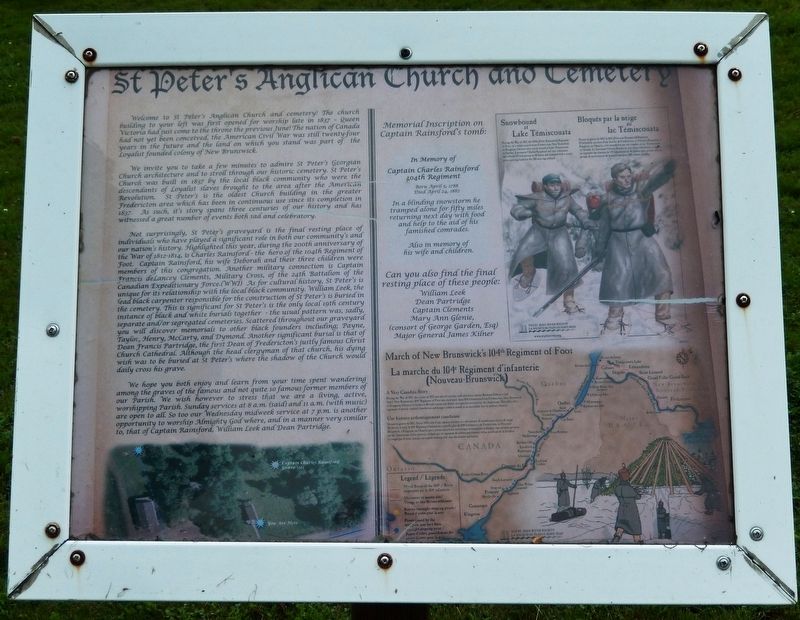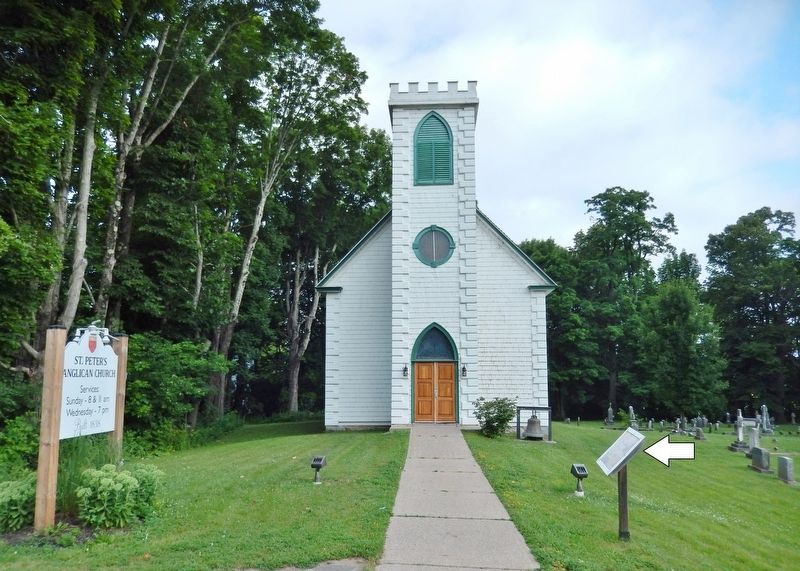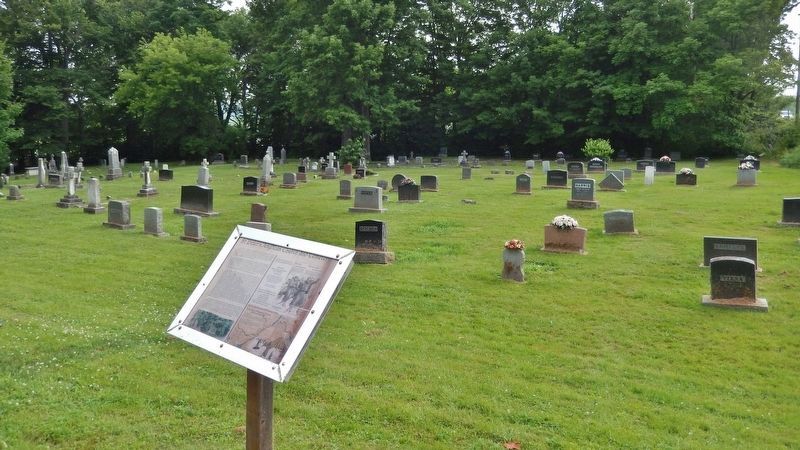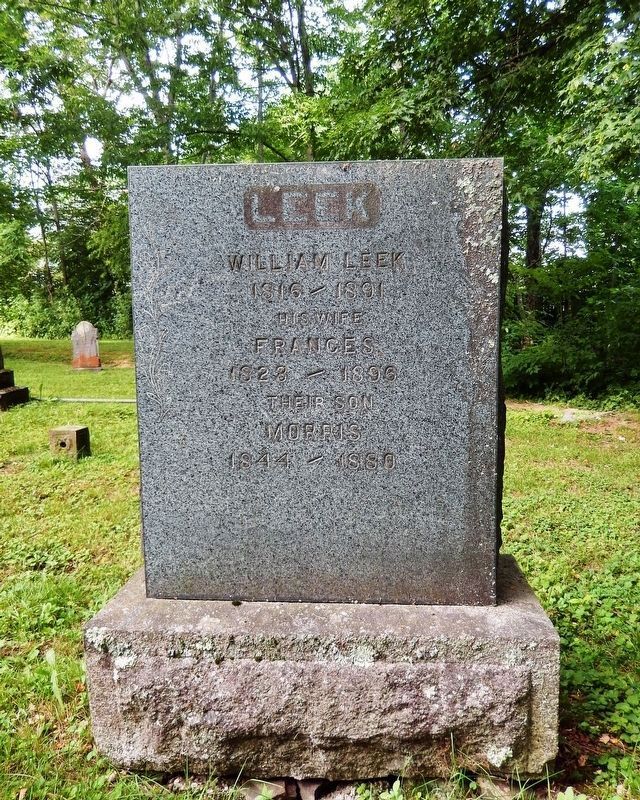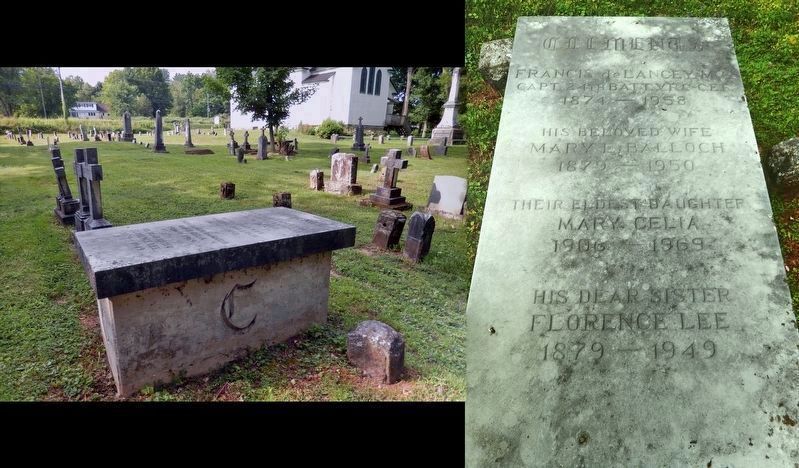Near Fredericton in York County, New Brunswick — The Atlantic Provinces (North America)
St. Peter's Anglican Church and Cemetery
We invite you to take a few minutes to admire St Peter's Georgian Church architecture and to stroll through our historic cemetery. St Peter's Church was built in 1837 by the local black community who were the descendants of Loyalist slaves brought to the area after the American Revolution. St. Peter's is the oldest Church building in the greater Fredericton area which has been in continuous use since its completion in 1837. As such, its story spans three centuries of our history and has witnessed a great number of events both sad and celebratory.
Not surprisingly, St Peter's graveyard is the final resting place of individuals who have played a significant role in both our community's and our nation's history. Highlighted this year, during the 200th anniversary of the "War of 1812-1814, is Charles Rainsford — the hero of the 104th Regiment of Foot. Captain Rainsford, his wife Deborah and their three children were members of this congregation. Another military connection is Captain Francis deLancey Clements, Military Cross, of the 24th Battalion of the Canadian Expeditionary Force. (WWI) As for cultural history, St Peter's is unique for its relationship with the local black community. William Leek, the lead black carpenter responsible for the construction of St Peter's is buried in the cemetery. This is significant for St Peter's is the only local 19th century instance of black and white burials together — the usual pattern was, sadly, separate and/or segregated cemeteries. Scattered throughout our graveyard you will discover memorials to other black founders including; Payne, Taylor, Henry, McCarty, and Dymond. Another significant burial is that of Dean Francis Partridge, the first Dean of Fredericton's justly famous Christ Church Cathedral. Although the head clergyman of that church, his dying wish was to be buried at St Peter's where the shadow of the Church would daily cross his grave.
We hope you both enjoy and learn from your time spent wandering among the graves of the famous and not quite so famous former members of our Parish. We wish however to stress that we are a living, active, worshipping Parish. Sunday services at 8 a.m. (said) and 11 a.m. (with music) are open to all. So too our Wednesday midweek service at 7 p.m. is another opportunity to worship Almighty God where,
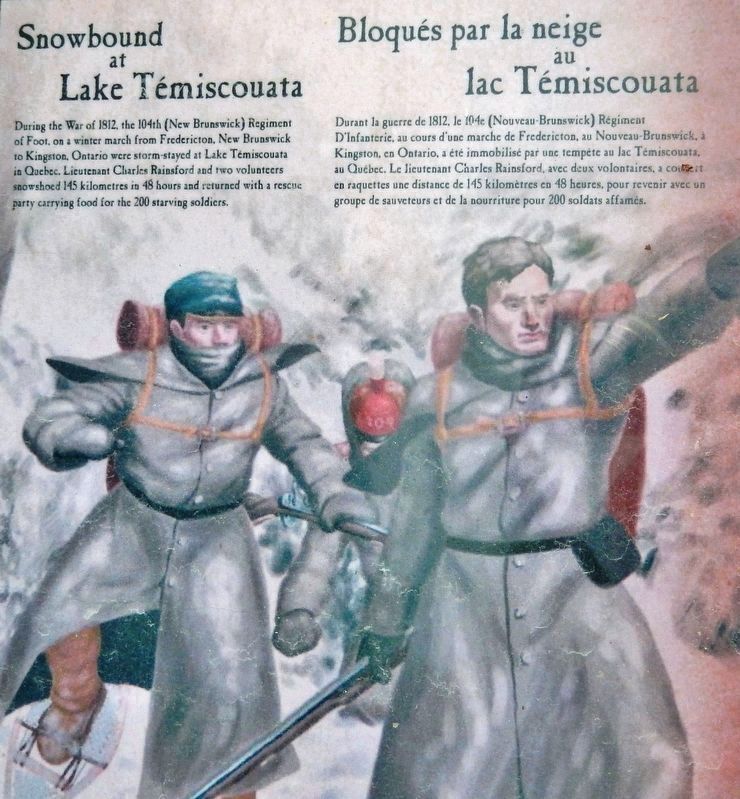
2. Marker detail: Snowbound at Lake Témiscouata
Bloqués par la neige au lac Témiscouata
Bloqués par la neige au lac Témiscouata
(English:)
Snowbound at Lake Témiscouata
During the war of 1812, the 104th (New Brunswick) Regiment of Foot, on a winter march from Fredericton, New Brunswick to Kingston, Ontario were storm-stayed at Lake Témiscouata in Quebec. Lieutenant Charles Rainsford and two volunteers snowshoed 145 kilometers in 48 hours and returned with a rescue party carrying food for the 200 starving officers.
(Français:)
Bloqués par la neige au lac Témiscouata
Durant la guerre de 1812, le 104e (Nouveau-Brunswick) Régiment D'Infanterie, au cours d'une marche de Fredericton, au Nouveau-Brunswick, à Kingston, en Ontario, a été immobilise par une tempète au lac Témiscouata, au Québec. Le lieutenant Charles Rainsford, avec deux volontaires, a couru en raquettes une distance de 145 kilomètres en 48 heures, pour revenir avec un groupe de sauveteurs et de la nourriture pour 200 soldats affamés.
Snowbound at Lake Témiscouata
During the war of 1812, the 104th (New Brunswick) Regiment of Foot, on a winter march from Fredericton, New Brunswick to Kingston, Ontario were storm-stayed at Lake Témiscouata in Quebec. Lieutenant Charles Rainsford and two volunteers snowshoed 145 kilometers in 48 hours and returned with a rescue party carrying food for the 200 starving officers.
(Français:)
Bloqués par la neige au lac Témiscouata
Durant la guerre de 1812, le 104e (Nouveau-Brunswick) Régiment D'Infanterie, au cours d'une marche de Fredericton, au Nouveau-Brunswick, à Kingston, en Ontario, a été immobilise par une tempète au lac Témiscouata, au Québec. Le lieutenant Charles Rainsford, avec deux volontaires, a couru en raquettes une distance de 145 kilomètres en 48 heures, pour revenir avec un groupe de sauveteurs et de la nourriture pour 200 soldats affamés.
In Memory of
Captain Charles Rainsford
104th Regiment
Born April 5, 1788
Died April 24, 1882
In a blinding snowstorm he tramped alone for fifty miles returning next day with food and help to the aid of his famished comrades.
Also in memory of his wife and children.
Can you also find the final resting place of these people:
William Leek
Dean Partridge
Captain Clements
Mary Ann Glenie, (consort of George Garden, Esc)
Major General James Kilner.
Erected by St. Peter's Anglican Church.
Topics. This historical marker is listed in these topic lists: Cemeteries & Burial Sites • Churches & Religion • Patriots & Patriotism • War of 1812. A significant historical year for this entry is 1837.
Location. 45° 57.985′ N, 66° 44.418′ W. Marker is near Fredericton, New Brunswick, in York County. Marker is on Woodstock Road (Route 102) half a kilometer east of Springhill Road, on the left when traveling east. Marker is located directly in front of St. Peter's Anglican Church, overlooking the cemetery. Touch for map. Marker is at or near this postal address: 2375 Woodstock Road, Fredericton NB E3C 1P6, Canada. Touch for directions.
Other nearby markers. At least 8 other markers are
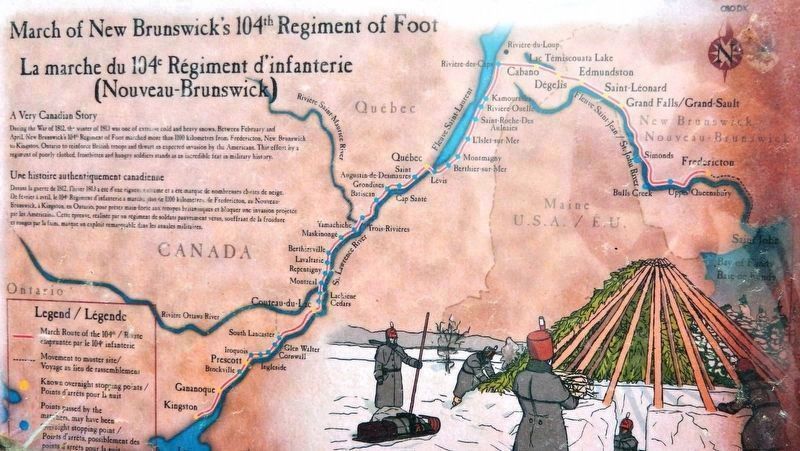
3. Detail: March of New Brunswick’s 104th Regiment of Foot
La Marche du 104e Régiment d'infanterie
La Marche du 104e Régiment d'infanterie
(English:)
A Very Canadian Story
During the War of 1812, the winter of 1813 was one of extreme cold and heavy snows. Between February and April, New Brunswick's 104th Regiment of Foot marched more than 1100 kilometers from Fredricton, New Brunswick to Kingston, Ontario to reinforce British troops and thwart an expected invasion by the Americans. This effort by a regiment of poorly clothed, frostbitten and hungry soldiers stands as an incredible feat in military history.
(Français:)
Une histoire authentiquement canadienne
Au cours de la guerre de 1812, l'hiver de 1813 a été marqué par une rigueur extrême et d'abondantes chutes de neige. De février à avril, le 104e Régiment d'infanterie du Nouveau-Brunswick a marche plus de 1100 kilomètres, de Fredericton, au Nouveau-Brunswick, à Kingston, en Ontario, pour renforcer les troupes britanniques et contrer l'invasion des troupes américaines que l'on craignait. Cet effort surhumain, déployé par des soldats mal vêtus et souffrant d'engelures et de la faim, demeure un fait d'armes extraordinaire de l'histoire militaire.
A Very Canadian Story
During the War of 1812, the winter of 1813 was one of extreme cold and heavy snows. Between February and April, New Brunswick's 104th Regiment of Foot marched more than 1100 kilometers from Fredricton, New Brunswick to Kingston, Ontario to reinforce British troops and thwart an expected invasion by the Americans. This effort by a regiment of poorly clothed, frostbitten and hungry soldiers stands as an incredible feat in military history.
(Français:)
Une histoire authentiquement canadienne
Au cours de la guerre de 1812, l'hiver de 1813 a été marqué par une rigueur extrême et d'abondantes chutes de neige. De février à avril, le 104e Régiment d'infanterie du Nouveau-Brunswick a marche plus de 1100 kilomètres, de Fredericton, au Nouveau-Brunswick, à Kingston, en Ontario, pour renforcer les troupes britanniques et contrer l'invasion des troupes américaines que l'on craignait. Cet effort surhumain, déployé par des soldats mal vêtus et souffrant d'engelures et de la faim, demeure un fait d'armes extraordinaire de l'histoire militaire.
Related markers. Click here for a list of markers that are related to this marker. New Brunswick's 104th Regiment of Foot
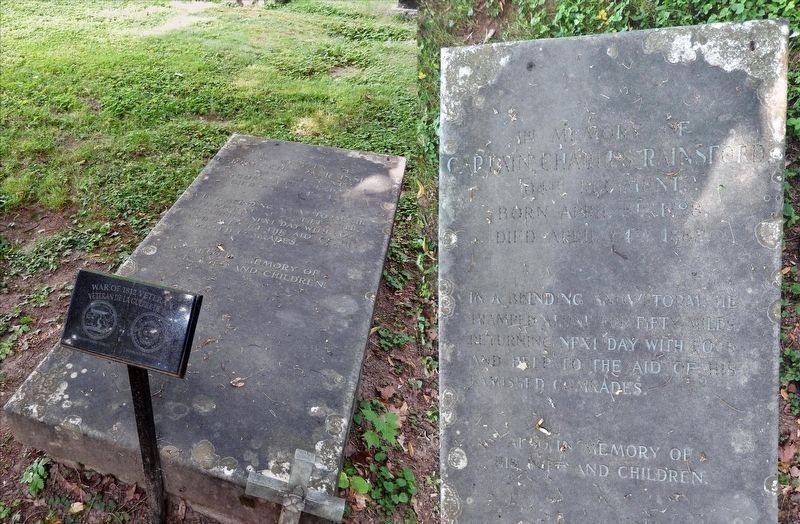
Photographed By Cosmos Mariner, July 31, 2019
6. St. Peter's Anglican Church Cemetery
Captain Charles Rainsford Tomb
Captain Charles Rainsford Tomb
Captain Charles Rainsford
104th Regiment
Born April 5, 1788
Died April 24, 1882
In a blinding snowstorm he tramped alone for fifty miles returning next day with food and help to the aid of his famished comrades.
Also in memory of his wife and children.
Credits. This page was last revised on July 8, 2020. It was originally submitted on September 5, 2019, by Cosmos Mariner of Cape Canaveral, Florida. This page has been viewed 229 times since then and 21 times this year. Photos: 1, 2, 3, 4, 5, 6, 7, 8. submitted on September 7, 2019, by Cosmos Mariner of Cape Canaveral, Florida.
